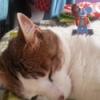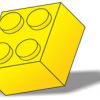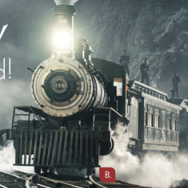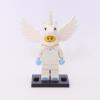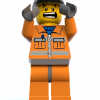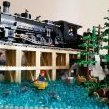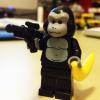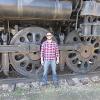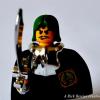Search the Community
Showing results for tags 'locomotive'.
Found 189 results
-
Hello eurobricks train tech!! I bring you today my first lego train moc. I am new to eurobricks so please point out any mistakes I may have made. I was inspired by scotnick's 14xx and decided to have a go at it. The construction of the model went very smoothly and I had originally used the 2x4 turntable for the trailing wheel. When I tested it, it wouldn't function properly and I had to replace it. So for two hours, I experimented with many different designs until I came up with one utilizing the ring plate and that err...longish blueish pin thingy! But it fit the bill and I'm happy! It is powered by the lego train motor with lights for the Lantern and the receiver in the cab. I do plan to build a autocoach to go with it which will house the battery box. Another problem I encountered was I had none of the I think 4x4 round bricks with holes in dark green, and since I don't buy any parts, I just used the 4x6 long half circle brick (I'm not that great with piece names!) And used some double sided tape to stick on the domes and an ausini clone brand chain for the chain on the front (I'm unarmed don't shoot! ) So stay posted guys, and look out for more projects coming soon! Comments and tips are very much welcome.
- 1 reply
-
- train
- locomotive
-
(and 5 more)
Tagged with:
-
"I've been working on the railroad, all the live-long day!" This train consists of a ALCO diesel locomotive (specifically a RSD-12 type) and six cars: - a (working!) crane car - depressed-center rail wagon - a (working!) ballast hopper - tool / worker bunk car - weed killer tanker - wide-vision bay-window caboose. The train model features several neat printed pieces found in several Juniors sets and and seven generic track workers. (as seen below) ...while the roadbed crew consists of: -Bucket-lift truck from set 3179 (Repair truck) -Dump Truck from set 7789 (Lotso's dump truck) Drill vehicle MOD from 7936 (level crossing) Front end-loader from set 7630 (front end-loader) ...and a official's inspection car MOC - not yet built This model was originally a ALCO MRS-1 built by Anthony Sava, but has been so severely modified that it no longer looks like the prototype loco. So I went searching And found another ALCO locomotive, a RSD-12 that looks like my loco. Both my model and the prototype have the six wheels, and the same basic hood and cab design. The long hood of the loco has been designated the rear with a double red light. (no picture taken yet of this car) This car is not your ordinary tanker car - it contains weed killer for use on the ballast the train lays down. This stream crane model was heavily inspired by Whoward69's instructions for a set of crane and match truck train cars. I modified the original model seen here. I originally meant for the crane to have ropes to move the boom, but it got confusing on which rope went where so for now it's moved by the H.O.G. (Hand Of God) method. The crane can spin around in 360 degrees and lift anywhere up to 90 degrees straight up. (Their is a double set of pins keeping the boom from going too low, as well.) Here we see how the crane is hooked up to the depressed center flatcar most of the time. The heavy-duty depressed-center wagon has brick-built arms to secure the cargo of railroad track in place. This model was inspired by a coal hopper on an older website called LGauge .com. I tunrned the old finger hinges into new pin-orientated ones and colored the car yellow to match the MOW paint scheme. The hopper's bottom door open and can dump 1 x 1 round plates / bricks onto the tracks for ballast. (no picture taken yet of this car) This is the workers tool car. In reality it's empty, but it's supposed to have rows of racks for tools, and a special box for broken tools to be fixed when they get back to the division HQ. The caboose features two ladders (one per side) and more of those fancy printed 2 x 4 tiles. This is where the job site foreman has a little office. The med kit is also located here. This is the headquarters for my Maintenance of Way operations for Brick Railway Systems. I was inspired by set 60009 (Helicopter Arrest) from 2013 for most of the building, while most of the inside details came from set 10027 (Train Engine Shed) in 2003 a whole ten years before the other set was even produced. As for the billboard on the roof, I borrowed the letter's design from my brother's model (with his permission), and put them on a billboard to spell out OCTAN. The tracks on the side of the building are for my ALCO RSD-12 and it's accompanying six car work train to sit and await their next task. The inside on the lower floor is furnished with a lathe, drill press, fire extinguisher, oil drum, and a vise. The upper floor (the break room) has a table, a few chairs, coffee machine (with paper cups!), fireplace, and a recycle bin. I will be updating this with the two missing pictures soon. As for the digital items, I will built them as funding allows. As usual, Comments, Questions and Complaints are always welcome!!
-
British Rail (BR) class 38 diesel locomotive - 7939 / 60098 inspired MOC
Murdoch17 posted a topic in LEGO Train Tech
The BR class 38 seen here is a one-off prototype. Engine number 7939 was made in 1989 to compare a Metro-Cammell made class 38 to a Brush Traction built class 60. The class 60 won the contract, and subsequently Metro-Cammell was sold and closed. The single class 38 soldiered on until 1997, when British Railways was fully privatized. The engine was then sold with a number of spare parts to Lego Rail Transportation Society, which has kept the engine running ever since as unit 7940. In the real world, the class 38 was never built. It was proposed and then dropped in favor of the class 60, which is what I based the story on. Metro Cammell really existed and was dismantled in 1989 sometime after loosing out to Brush Traction for the class 60 contract, and everyone knows that British Railways was taken apart in the mid-1990's. This LEGO model is a mash-up of a William Howard's diesel locomotives and the official Lego sets 7939 and 60098, with a set of Anthony Sava-derived three wheel sliding bogies. The rear of the bidirectional loco. The numbers "7940" go on printed 1 x 1 tiles on the sides while "LRTS" goes on the front and rear ends. The color scheme for this model was inspired by the British Rail Class D16/1 (also known as LMS engines 10000 and 10001), the first two mainline diesel locomotives in Great Britain. (see here for more on them.) Both ends of the locomotive have a engineer's cab that opens up to seat a figure at the controls, just like sets 7939 and 60098. (I just noticed there is one letter spot too few on the ends of the loco for the railways name as seen in the pictures, as there should be four studs, not the three shown) Bricksafe LDD file link: BR class 38 file Comments, Questions, and Complaints are always welcome! -
This project was my first After getting the horizon express (my awakening from the dark ages), tried to learn something using the lone ranger constitution train, and a file or two from Murdoch17 (whom I cant thank enough, for helping the newcomers like I was, with the lxf files available), and after some modding and a trick or two here is the never ending project of mine, soon some passenger wagons to be added, for now just the locomotive and tender in black and white, literally... rahzmocOldWestwip01 by Rafael Costa, no Flickr rahzmocOldWestwip02 by Rafael Costa, no Flickr rahzmocOldWestwip03 by Rafael Costa, no Flickr
-
Another creation for diorama on incoming event - in winter edition. No interior has been made. I also try to put on some icicles, but I didn't like them at all. When I'll put it on diorama, some utensils, decorations and accessories will be added. For now it is, what it is. Credits for "Stop buffers" goes to Karwik. I like the idea, but I made my own version of it.
- 15 replies
-
- locomotive
- garage
-
(and 1 more)
Tagged with:
-
I have always thought about certain trains in lego. These are some I haven't seen. images are glitchy. Cnj g3 pacific Southern 630 prr turbine feel free to comment. I would love to see others you know of.
-
I just need some tips to build a steam loco. what parts would look good? also, would a single axle front truck, unflanged driver unflanged driver flanged driver unflanged driver config work?
- 4 replies
-
- steam locomotive
- train
-
(and 2 more)
Tagged with:
-
ALCO diesel RSD-12 loco (6 wide) train MOC - real world build
Murdoch17 posted a topic in LEGO Train Tech
This model was originally a ALCO MRS-1 built by Anthony Sava, but has been so severely modified that it no longer looks like the prototype loco. So I went searching And found another ALCO locomotive, a RSD-12 that looks like my loco. Both my model and the prototype have the six wheels, and the same basic hood and cab design, plus the curved ends match the RSD-12 better than the sharp-ended MRS-1. ..and here is my Lego model of it, as Brick Railway Systems loco number 7924. I even thought about putting two of this part under the headlights at both ends, but I think the model looks better the way it is now. NOTE: The printed letter tiles with the railroad's initials "BRS" will go on the long hood. I misplaced the two letter "R" tiles, and need to order some more, but the rest of the letters are on my desk. (They are hard to keep from rotating without the middle letters to hold the others in place, so they are not on the model yet.) The center axles on these six-wheel bogies slide left and right to allow for tight turns on switches and flex-track. I took Anthony Sava's original design and beefed it up, making it a lot stronger and a little taller. Here is the picture (not mine) I found that matched my model. I also believe this is the last ALCO RSD-12 left. (I could be wrong, though.) The photo is originally from here. Here is the LDD file for the diesel loco as shown above. Comments, Questions, Suggestions, and Complaints are always welcome! -
Six-track railroad locomotive transfer table - real world MOC
Murdoch17 posted a topic in LEGO Train Tech
I had a spare truss bridge model lying around and thought it could use a revamp. Then I thought of the turntable I had designed, and realized it could use a transfer table companion model. Thus, this transfer table was finished just today. The whole table moves on four wheels at the edges and three guide-ways in the center. The model sits on four vintage 32 x 32 stud base-plates arranged in a square. I'm currently thinking about slicing up what's left of a gray 48 x 48 into a strip for the leading tracks to rest on. The height from the track to the top of the truss-work is a hair shorter than 13 1/3 bricks tall, which is tall enough for most locomotives but not enough for cabooses, extra-tall double stacked container cars and double-decker lounge cars. The length of the table is four tracks long, which is plenty for any of my single-unit locomotives or official LEGO models. (Diesel cab and booster units will have to be split up to fit, however.) In progress shot of me loading a 4-8-2 steam locomotive onto the table. Lining up the tracks as perfect as can be is key to keeping the loco on the rails and steady! Moving any loco sideways is easy enough to do with one hand... lining it up and rolling the engine off, however, needs steady two hands and a good eye. A better pic of it lined up at the shed track after unloading the steamer. Please NOTE: There is a two stud gap (and a bit of incline) between table and lead-in track: It is NOT 100% flat! Comments, suggestions, complaints, and compliments are always welcome!- 6 replies
-
- moc
- transfer table
-
(and 8 more)
Tagged with:
-
Missed out on the Lego Emerald Night. I reckon that I should build my own steam locomotive instead of getting one on the market. After few months of bricks purchases, precious advice from fellow Eurobrick members(e.g. Motor power functions Torgue, learned about quartering technique), and several rounds of reworks and modification, it is finally completed! Sharing my 8-wide build Santa Fe 4-4-2 "Atlantic" Locomotive, with Cargo Wagon and Passenger Car. Hope you guys like it! Train: Santa Fe 4-4-2 "Atlantic" Locomotive Specs: Engine [8-Wide]. Tender [7-wide], Cargo Wagon [8-wide], Passenger Car [8-wide] Power functions: 1 x XL-Motor, 1 x Power Function Light (Front Lamp and Rear Boiler), 1 x AAA Battery Pack, 1 x IR Receiver, 1 x Extension Wire This is the one of the only few photos of ATSF which I can find for reference during my build:
- 18 replies
-
- locomotive
- atsf
-
(and 1 more)
Tagged with:
-
Hello! I have been a member for a while and first jumped into Eurobricks with a tread about my Rise from the Dark Ages full of all the things I had be building in LDD. Now I present to you, the locomotive that started my whole enlightenment in the first place. The Union Pacific 4000 class. I chose to number mine after 4017 which is on display in Green Bay, Wisconsin since that is the one I have gone to see. If you poke around my Flickr long enough you might be able to find some earlier versions than the one you see in the photos below. I'm sorry I do not have professional photos this engine made its debut at the last NILTC show this past weekend. They were gracious enough to let me join them. I know some of them took a whole lot more photos and videos than I but here are a few that I have. Coaster was there and it was a real treat to see this run through his custom R104 double cross-over. For some interesting notes: The version in brick is 8.4. That is I have almost completely rebuilt this 8 times in LDD and have made 4 minor revisions. This engine has 2 XL motors in the boiler and is geared to the same as the Emerald Night. BrickStuff lighting gear lights up the head light, the front marker lights, the cab, and the rear red light on the back of the tender. I do plan to do a proper photo-shoot but I am moving soon so it will not take place until some time this summer. In the mean time...enjoy!! I would love to hear all comments and critiques. This next is not very good, but it handles curves just fine. I'm sorry I don't have any videos yet...but I have one and will post it later. I hope you enjoy and I will update once I have had time for a proper photo-shoot!
- 23 replies
-
This engine is modeled after the GE 44 ton switcher locomotive. Why 44 tons, you may ask? I give you the answer from the Wikipedia article on this loco type: This locomotive's specific 44-short ton weight was directly related to one of the efficiencies the new diesel locomotives offered compared to their steam counterparts: reduced labor intensity. In the 1940s, the steam to diesel transition was in its infancy in North America, and railroad unions were trying to protect the locomotive fireman jobs that were redundant with diesel units. One measure taken to this end was the 1937 so-called "90,000 Pound Rule" :[citation needed] a stipulation that locomotives weighing 90,000 pounds (41,000 kg) – 45 short tons – or more required a fireman in addition to an engineer on common carrier railroads. Industrial and military railroads had no such stipulation. The 44-ton locomotive was born to skirt this requirement. The loco is bi-directional, and doesn't have much to differentiate between the "front" or "rear" expect for the air horn and exhaust stack on one end in real life. My LEGO model lacks these, so it's only way to tell which is front is by the headlights: clear for front, red for rear. I am going to name this loco WFP number 7007. (WFP stands for Wabash Frisco & Pacific, which is the name of a 12 inch gauge ride-on railway in St. Louis, MO.) They don't have a real 44 toner there, but do have a Fairbanks Morse H10-44 (number 704) in the same color scheme, so I made this engine as a companion to the H10-44. In the spoiler tag below, you will find a real life picture of a 44-toner loco. (I got the picture from railpictures.net, It is NOT mine!) Just for comparison purposes, here is the H10-44 I was talking about. NOTE: The H10-44 is NOT included in the GE 44-ton's LDD file! The (updated) LDD file for the GE loco is available here. Build updated 3-14-17 with a better 44 ton GE unit, courtesy of Henry Durand over on Facebook's LEGO Train Fan Club. Thanks Henry! Comments, Questions, suggestions and complaints are always welcome!
-
Hello, This is my first MOC in EB Train Tech however I've been following this forum since years (building some other MOCs you can find in my Flickr photo gallery). First of all, thank you guys for inspiration :) I really enjoy my time reading your posts. Erie Triplex was already built by Shuppiluliumas, and by Lego Train 12 Volt, really great models! (sorry if I missed other creators) I tried to do my own recreation of this distinguished loco. Please have a look and comment. I decided to use sand green + flat silver curved slopes, added a bit of glamour with few extra gold chromed parts :) Dimensions and PF: Length: 82 studs Width: 10 studs Height: 11 bricks PF: 3x L-motors + Sbrick controller + 88000 battery Weight: 1,6kg Non-standard solution and technics:: 1. To add more realism I used well-known rods from Zephyr (TrainedBricks http://www.bricklink.com/store/home.page?p=zephyr ) 2. SBrick ( http://sbrick.com ) 3. Chromed parts from Aurimax ( Chrome Block City http://www.bricklink.com/store/home.page?p=Aurimax ) 4. Trimmed technic axle (BL #6587) to connect rods with wheels (I know the solution how to connect it in proper Lego way, but this change is on my to-do list ) 5. Bullfrog Snot on 2 pairs of wheels ( http://www.bullfrogsnot.com/faq.asp ) but finally I decided to add white o-rings 6. Stickers Lady in black & white Movie Cheers
-
OCTAN diesel refueling depot with Santa Fe Bluebonnet F7 units
Murdoch17 posted a topic in LEGO Train Tech
Inspired by set 149 (Fuel Refinery) from 1976 as seen above (pic from BrickSet), this model takes the 4.5v era Shell refinery and turns it into a two-bay diesel locomotive / oil burning steam engine fuel depot for the modern PF age. The new refueling depot model features two floors with removable roof sections, two track-bays for servicing locomotives, plus a 1950's style tanker truck inspired by set 8486 (Mack's team truck, which hasn't been built yet.) The Santa Fe Bluebonnet model proudly uses no stickers, only printed parts. It's road number (327) is of a real-world Santa Fe bluebonnet engine, one that no longer survives after it's eventual conversion to a CF7 and scrapping sometime later. Sadly, all the Santa Fe F-series diesels were converted to CF7's, (whole body shell stripped away for viability reasons) and boy, were they ugly. Not many of the CF7's survive today, if any. As a side note, the locomotive bays are tall enough to let any official car through, including the double stacked container car from the Maersk train. The upper floor of the depot features a control station for monitoring the flow of fuel from the tanks on the roof to the service bay, or from the as-yet-unbuilt tanker truck to the storage tanks. The roof of the facility comes off in two sections. The upper floor features a opening door to the tanks and staircase to the lower floor and the flow-monitoring systems. Emergency fuel shutoff valve and fire extinguisher are at the top level next to the door to the tank area. This is a heavily modified version of set 8486 (Mack's Team Truck) 1950's style semi truck, like the one seen in the 1970's Spielburg movie "Duel". This time, it's a tanker truck in the OCTAN colors scheme. The model can seat one mini figure at the wheel, and features opening doors, a removable roof and a detachable tanker trailer. The tanker section features a moving stand to keep the tank stable when the cab is not there. The trailer is supposed to feature this print on both left, right and rear sides of the tank where the white 1 x 4 tiles are. The idea for this bluebonnet came to me in 2014 when I came upon @raven1280's very similar model, as seen here. I didn't want to use stickers at that time like he did, so I waited, modifying and tweaking the design until the parts came out in the correct colors to warrant it's building. (Particularly the windscreen!) Inside of the cab unit. Inside of the booster unit, with cab unit connected on the left hand side of this locomotive. (Yes, I placed it backwards to what it should be!) (NOTES: Real life model 98% done, just need the tanker truck built.) As usual, Comments, Questions, Suggestions & Complaints are always welcome!- 12 replies
-
Green 2-6-2 (Prairie) steam loco with matching passenger train
Murdoch17 posted a topic in LEGO Train Tech
This 2-6-2 Prairie type engine was inspired by the My Own Train series of 2001 and a boiler from set 79111 (Constitution Train Chase). The passenger coaches and baggage car were inspired by set 10015 (Passenger Wagon), and set 10194 (Emerald Night). They feature no interior but all three passenger cars have four opening doors. The baggage car has two opening doors, two sliding panel-doors and an "exploding" back wall inspired by set 79111. (Constitution Train Chase). The whole train together. Here we can see the rear of the train with the back wall (and dynamite) still in place. (You may notice the baggage car is a modified version of the green Western jail car I already have built) The yellow 1 x 4 bricks used are actually supposed to be green printed bricks with this on them. The tender features a coal bunker, and water tank, plus a ladder at the rear for accesses to the passenger train. The cab features a firebox door (a 2 x 2 round tile) and two printed gauge tiles. The coaches were inspired by set 10015 (Passenger Wagon), and set 10194 (Emerald Night). They feature no interior but all three passenger cars have four opening doors. The exploding baggage car was originally the Jail car from set 79111. (Constitution Train Chase) while gaining the styling of set 10015 (Passenger Wagon) and doors from 10194. (Emerald Night) This car has one play feature that is sure to blow you away: the back wall can be removed to get at the baggage compartment via the "dynamite" on the outside of the back wall. (actually, the roof top lever knocks the wall loose) Then your train robbers can make off with whatever valuable are inside! As usual, the LDD file for the whole train is seen here while the loco and tender by themselves are here. Comments, Questions, Complaints, & Suggestions are always welcome. This train is on my to-do list, but won't be built for a while... maybe this summer? -
Howdy! This is an update of a post I made earlier this year of a Durango & Silverton K-36 narrow gauge locomotive. I recently decided to submit this MOC to the Lego Ideas website as an effort to get Lego to produce more quality train sets. I shared my project with the good people at the Durango & Silverton Narrow Gauge Railroad, and I have been blessed to receive their full support and endorsement of my efforts. I consider the D&SNGR to be the finest railroad experience in the country, if not the world. If you haven't had the good fortune to ride with them, do yourself a favor and make plans to go as soon as possible. You will not be disappointed. Check out their Facebook page for information about the railroad and a look at their endorsement of this MOC. https://www.facebook.com/DSNGRR/ If you are passionate about Lego trains, as I am, please visit the Lego Ideas website and show your support for this MOC. Help me convince Lego to make this dream a reality and immortalize the great D&SNGR with the world's greatest toy! https://ideas.lego.com/projects/161449 Back to the MOC. Let's start with the engine. I am not a fan of Lego Digital Designer, so all of my MOCs are built through a trial and error evolutionary process. This is the first picture I stopped to take of the locomotive. By this point, I had nailed down the frame, wheels, and the driving mechanism. I opted for including all the power functions elements in the locomotive rather than the tender. Working on hiding the power functions. Taking shape Experimenting with the stack and the headlight. Finalizing front end. On to the cab. Getting close. Power functions access from the top. The motor makes a nice firebox. A glimpse of how the wheels are powered. Done! Now for a look at the evolution of the passenger car. Finally settling on the SNOT technique for duplicating the look of wood panels and windows with depth. Placing a horizontal stripe in the middle of vertically striped plates was a fun challenge. I eventually found a way to suspend the upper non window portions from the ceiling. I really enjoyed building this car. All done! I didn't really take any pictures of the caboose process. I essentially used the same techniques from the passenger car. The inside is pretty ugly though, as I only had so many pieces available in this color of red. Now for a few shots of the train all together! How about a little scenery? From the good folks at the Durango and Silverton Narrow Gauge Railroad! I took the train to Brickfair in Birmingham, Alabama, and it won staff favorite! Kids loved the bear in the cave. Brickfair is a blast. I highly recommend it to anyone interested in Lego or anyone with kids.
- 16 replies
-
4-8-0 steam loco with generic six car US freight train - real life models
Murdoch17 posted a topic in LEGO Train Tech
This 4-8-0 "Mastodon" type steam engine & it's six car freight train are hauling generic cargo on it's way to Anywhere, USA. This engine model was first built as a 2-8-2 Mikado (with running gear derived from Scotnick's 2-10-0 Decapod 9F) before having the front pony truck removed and a 4 wheel bogie from set 10194 (Emerald Night) added instead, turning it into a 4-8-0 Mastodon - type. The rear pony truck was removed as well, with the 79111-style boiler shortened and cab re-arranged. Together, these several different engines from four different eras and four separate builders come together to create this one 4-8-0 "Mastodon" type steam engine The coal tender was inspired by Anthony Sava's Pacific 4-6-2 model's oil tender with the letters "BRS" added in the middle of the tender using printed 1 x 1 tiles. I think the loco is much better proportioned to the tender now than before. In my fictional universe, the engine above pulls a generic mid-1900's freight train. This train consists of the following models: This drop side flat car was first part of set 2126 (Train Cars), but it didn't really have a purpose. It was hauling uprooted evergreen trees in the set, but that didn't look very good, so I changed it to generic freight. (My resident hobo usually catches a ride on this car.) This tanker car was inspired by set 7939 (Cargo Train, 2010 version) and by Anthony Sava's recent pick-a-brick MOC-up tanker car. (seen here.) I was inspired by this photo by JB Lego to build this boxcar (seen here ) They are made to haul generic freight, such as anything from unfinished car parts to prized paintings... and yes, the doors do open! Inspired by the green tractor trailer from CITY set 4204 (The Mine), this bathtub gondola is carrying boulders from the mine destined for the gold refinery where they will be opened up and the metal extracted to make coins and ingots. I have adapted this UK inspired model of a brake van by Fireglo450 (see it here ) to be a more American inspired caboose. The caboose has no interior, and the red marker light can go on either end of the model to represent the end of whatever train it is being hauled behind. -
Hi everyone! A little while since I completed and posted my creations. Winter is here, and Christmas is coming, and I think it is time to do something for my winter village. Here is my first try on making a train MOC, and it is an interesting building journey. I have looked at different beautiful locomotive engines online and created my version with a little seasonal deco. I don't want this to be a funny, cartoon Christmas tree, but a formal and decent express train going between the city and the winter village. The engine is the part that took me most time to create. I had the basic form in my head, but the mechanism and details actually required quite some understanding of the actual old locomotives. Luckily, the green Emerald Train gave me much hint and so I ended up with this: I added some interesting details to the front bumper part, using the claw pieces. I also tried a "tilted bottle" arrangement for the chimney part. The engine probably runs on diesel as there is no coal section. The wagon car follows the engine, and that is how you get your presents at the winter village! Freshly delivered from the city center! The passenger car is a simple one with all you need: doors and windows, and a streamlined profile. It looks like it has warm air supply already for your long journey through the winter: The last car is a mail car. Of course, you need to deliver a lot of parcels and Christmas cards to the villagers from the city. So, have we arrived yet? Yes, this is it! Hope you guys like it! :D Have a merry Christmas! ;)
-

[TC10] Pneumatic Locomotive
The_Brown_Hornet posted a topic in LEGO Technic, Mindstorms, Model Team and Scale Modeling
Greetings All, Apologies for being very late to the party, but the TC10 pneumatic competition brings together my favourite parts of what technic is all about and I really wanted to contribute. A number of years ago I had to good fortune to come across a big bunch of pneumatic parts. Having worked on all sorts of pneumatic based MOC's my beloved wife put out the challenge to build her a steam train thus beginning a five year odyssey before finally arriving at the model I present to you all today. Creating a genuinely functioning Lego Pneumatic Locomotive has been a real challenge, searching the internet brings up very few examples. Creating a valve assembly that is both functional and reasonably robust within the confines of lego has proven quite the challenge. Rather than completely reinventing the wheel, I have based my model on a simplified version of Walschaerts Valve Gear that was used on many steam trains through history. I set out at the start of this competition to make a fully reversible valve gear as per the real thing but it proved too much of a challenge at this stage - see how the next few years pans out. The Model: Classic 4-8-2 locomotive configuration using 62.4 tyres for driving wheels old style clear pneumatic cylinders for drive old style pneumatic valves Six manually operated pneumatic pumps - this thing need lots of air. All parts use are original, unmodified, genuine Lego items. The reason I have used "old" style valves is that they are the ones that I could find with minimal resistance, allowing the whole system to function property. Starting with the final result for those of us into instant gratification; This is the final interpretation of my pneumatic locomotive. I will, however make you scroll further for the video. The key to the success of this model is has been in effectively copying the principals behind the walschaerts valve system where the throw of the valves is delayed by the eccentric on the main driving wheel. It is only once the piston ( pneumatic cylinder) has reached the end of it's stroke that the valve is thrown in the opposite direction to push it back the other way. The two valve trains on either side of the loco are offset by 90 degrees so that they "help" each other past the dead spot at the limits of each cylinder's stroke. No matter what I tried, the fundamental principal was "More Steam Coalmam!' In manual form, 6 pumps are required to provide adequate air supply. Four air reservoirs for the testing phase and three in the final model smooth the pulses from six manual pumps to a point that we have reasonably smooth motion. Lucky last, a brief video showing how it works. I'll try to post an ldraw of the basic mechanism in the not too distant future but instructions are well outside my current skill set. If you've got this far, thanks very much for taking the time, I hope it's proven interesting. The Brown Hornet- 28 replies
-
- train
- locomotive
-
(and 3 more)
Tagged with:
-
Classic 1980s-style passenger train with streamlined GG-1 style locomotive - real world MOCs
Murdoch17 posted a topic in LEGO Train Tech
The coaches are inspired by train sets 7715 / 7718 from the 4.5 Volt era in the early to mid 1980's. The Lego Land Railway runs the train from World City to Heartlake City with stops at Classic Town, Paradisia Coast, Duplo-Ville, Ninjago City, (where the electric loco is replaced by a steamer or vise versa for the rest of the trip) Fabu-Land, Technic Town, Fort Legoredo and the Castle Realm. (with extensions into the Forest of Failed Themes and the Outer Dimension of Galidor at certain times of the year.) As both sides are the same (even for the headlamp color), I decided to take only one picture of the ends of the loco. This model was inspired by both a 1999 version of the engine built by Flickr user legosteveb user and a couple of digital-only designs by @Sunder. The pantographs on top are inspired by set 10277. (Crocodile locomotive) Unfortunately, this is as low as they go because I built them from pictures and didn't do it right. (Oh well!) Fictional history: This electric engine (number 9028) was originally designed as a un-streamlined freight workhorse for use in the mountains of the Western half of the North American continent on the electrified section of the Lego-Land Rail-Road mainline back in 1925. The engine uses a 2-C+C-2 arrangement, which means single frame (really, it's split in two in the middle, as the curves were too tight to do one single piece, but that's just too technical.) mounted upon a set of two axles unpowered (the "2") and three axles powered (the "C") hinged with the ball and socket to another frame of the same design (the +). The unpowered "2" axles are at either end of the locomotive. As you can see, the three axles in the middle two sections are connected by drive rods. After serving dutifully for around seven years as a freight loco, the engine was upgraded to a fully streamline-shrouded passenger unit after another of it's eight-strong class was written off after a accident with a stuck Shell tanker truck blocking a road crossing. (Thankfully, the steeple-cab design protected the crew, who survived!) The 9028 was also given a higher gear ratio in it's trucks, to allow for the higher speeds that the passenger schedule called for. The engine's class has a reputation as a tough hauler, taking care of almost anything thrown at it in freight service, and plowing through the most impossible schedules as passenger engines. There have been times, however, when they have been helpless: In January 1952 engine 9030 and of the premier Lego-Land Rail-Road trains (The City of Heartlake) got stuck in the Rocky Mountains due to a large snowdrift on the tracks and 100-MPH winds in blizzard conditions. They got boxed in, and were stuck there for six days before rescue crews could reach them. (This actually happened to the real world City of San Francisco train in the Sierra Nevada's in January, 1952. The rotary snowplows froze to the rails trying to get through!) (picture coming soon) The engine features moving panto-graphs for picking up (imaginary) electricity from the overhead wires. They are both in the lowered position here, though normally the one closest to the train it was hauling would be used. The exception to this was if the rear panto-graph was knocked off or damaged by overhanging debris, which the engine would then have it's lead panto-graph raised in order to limp to the repair shop. This baggage / passenger car is called a combine which is short for "combination". All the doors can open on this train, even the sliding ones shown here. The three 1980's-style coaches are identical in every way. The observation car, the rear-most coach on the train, features a platform for sight seeing. Comments, questions, and complaints are always welcome! EDIT 12/17/19: Added revised real life pictures. Comments, questions and suggestions are always welcome!- 13 replies
-
Spirit of Legoredo streamlined train with 4-8-4 "Red Dragon" steam locomotive
Murdoch17 posted a topic in LEGO Train Tech
The Spirit of Legoredo was my one of my first big trains, and was built in 2011 with a baggage car, three passenger coaches, and observation car. It looked good to me at first, in nearly all black with a red stripe at the base, but over the years was quietly forgotten about, as it was quite dull-looking to others and hard to take pictures of. Then I switched magnet types to the newer ones, and it became even harder show off as it didn't match the rest of my newer train fleet. That is, until I added a new locomotive to the head end and one more passenger car. (changing the colors up a bit from mainly black to mostly red doesn't hurt much either!) In reality, this 7-wide loco began life as a 2-8-4 Berkshire type built by @Plastic_Goth and purchased from Rebrickable a seen here. I upped the wheel count by another leading axle, (making it into a 4-8-4 Northern-type) and I then decided to imitate the famous South African Railways 'Red Devil' in color-scheme. The pistons are entirely my own work, as is the tender. More details can be seen here on the SAR Red Devil locomotive. The rear of the engine has a slightly changed coal bunker side walls compared to the 2-8-4 Berkshire MOD I posted earlier in the week. The baggage car. These cars were all inspired by The Santa Fe Super Chief cars (10022 and 10025) and the Emerald Night's coach. (10194) The four streamlined coaches of the train. Each car on this train is 28 studs long, which is longer than my usual 24 studs long standard. Observation car of the Spirit of Legoredo passenger train. The original way these cars were styled had them all black and with a red base stripe, but I have added dark bluish gray fluting and a lot more red to the mix to make them easier to take pictures of. Comments, questions, and complaints are always welcome! EDIT 4/23/21: Added a different steam loco to the fist post. -
After some conversation in another thread I realized I haven't posted any of my more recent builds on here, including one of my boxcab electric locomotives. I figured I would put some details about both of my New Haven electric locomotives, since both fit this category. Many of you may have seen these on Flickr or at shows but I presume that many of you haven't seen them yet, though I could be wrong. First up is the newest one, my New York, New Haven & Hartford Railroad (NYNH&H) EF-1: The EF-1 class was built in 1912 by Baldwin-Westinghouse and remained in service until 1957 (outlasting their "successors," the EF-2's by 9 years). The were frequently used on the New York Connecting Railroad (a joint venture to connect the New Haven and Pennsylvania Railroads) hauling freight from New England to the Long Island Rail Road's transfer bridges in Brooklyn, NY. Due to the grades on this route they were typically operated in triple, and I've even seen a photo of four of them hauling a long freight over the Hell Gate Bridge. The model is equipped with two PF train motors which power the four large drivers, and Brickstuff lights in the main headlight and four front marker lights. Contrary to everything I've read on here, I've had no problems using large drivers on a PF train motor (well, none yet). My plan is to build freight cars until this can no longer haul any more, then build a second and repeat until I have three of them. My second (well, first) boxcab electric is my NYNH&H EP-3: The EP-3 class was built by General Electric in 1931, and featured both pantographs and third rail shoes so they could run into either Grand Central Terminal or Pennsylvania Station in New York. The EP-3s performed so well that the Pennsylvania railroad borrowed three of them for tests that resulted in the design of the world famous GG1. As with my EF-1 this uses two PF train motors powering eight of the large drivers, and was able to keep considerable speed at Brickworld this past summer with five heavy passenger cars in tow: New Haven Meet at Brickworld Chicago Also I'm working on a NYNH&H EP-2, which is still very much of a WIP: Cheers!
- 18 replies
-
- Boxcab
- Locomotive
-
(and 2 more)
Tagged with:
-
EP-2 "Bipolar" electric locomotive - Milwaukee Road - real world MOC
Murdoch17 posted a topic in LEGO Train Tech
Confession: I have been wanting to build a Bipolar for a long time, about six years. Longer than the Daylight or my Aerotrain models have been around, even on my computer, and longer than most of my 80+ strong fleet. Now, after years of waiting and thinking, designing and re-developing: it is here! But first, here is what it's based on: The Real life inspiration: The LEGO model of this engine is sitting on the side of the real locomotive. Real life inspiration: From 1919 to 1962, the Chicago, Milwaukee, St. Paul and Pacific Railroad (known as the Milwaukee Road) had these five General Electric-made behemoths pulling trains under the wires on two sections on the Pacific Extension, pulling trains part-way on their journey to Seattle or Chicago. They were called the Bipolar's for each of the locomotive's 12 motors had only two field poles, mounted directly to the locomotive frame beside the axle. The motor armature was mounted directly on the axle, providing an entirely gear-less design. These locos were so powerful they could out-pull modern steam locos, and what used to take two steamers took just one bipolar. However, after a disastrous 1953 rebuilding by the railroad's company shops (who had no clue how to work on a electric loco) the engines were prone to failures and even fire. And so, in 1962, four of them were scrapped with the lone survivor, numbered E-2, towed to the Museum of Transportation in St. Louis Missouri, where it has sat silent even since. LEGO Model: This model was inspired by a 1999 version of the engine built by user legosteveb. I recreated the actual orange, red and black color scheme used on the loco when it emerged from that 1953 modernization program, but it was too expensive. So, after looking around I decided to use the paint scheme the Milwaukee Road used when the engine was donated. This yellow and red scheme was inspired by the Union Pacific and was adopted very late in the engine's career (mid-50's). As both sides are the same except for the headlamp color, I decided to take only one picture of the ends. As you may have noticed, the LEGO version has two "floating" third axle bogies that were inspired by Anthony Sava that allow the engine to float over switches and curves easily. The engine runs beautifully over the little bit of track I have access to, but due to my lack of a layout and tables at the moment, (I've been forced to pack it all up for now) I couldn't get any pictures of that taken. Here is Steve's original model from 1999. Comments, Questions and complaints welcome! EDIT 8/17/18: Well, it's taken about six years of planning, designing, and redesigning, but it's finally on it's way to the real world. The Milwaukee Road "BiPolar" electric locomotive has been ordered as of the 12th in the form as shown. (minus the blue letter overlay I added in MS Paint, of course!) Keep your eyes peeled for real life pictures! EDIT 8/20/18: Real world pictures added! -
ALCO FA + FB diesel units (6 wide) - real life MOC models
Murdoch17 posted a topic in LEGO Train Tech
MODS: the last topic i made on this train was long ago (2013) I thought that making a new one instead of resurrecting an old one and updating it would be better... though I could be wrong. if so, I am sorry for any trouble I have caused! The locomotive is a American Locomotive Company (ALCO for short) diesel two unit semi-permanently coupled set, with both engines assigned the same number. The front unit where the engineer sits is called a Cab (or A) unit, while the trailing unit is called a Booster (or B) unit, though they can be used in more groups than just two, like a an A-B-B-A set as used on the real life Santa Fe Super Chief, among many other trains. This feature was not unique to the ALCO family, as Baldwin, EMD, and many smaller makers such as Fairbanks - Morse did so too. However, sometimes different companies' types were difficult (or impossible) to connect together because of placement of Multiple Unit control hoses / ports. (Like a ALCO A unit leading a Baldwin B unit, a Fairbanks Morse B Unit and a EMD A unit at the rear... though it would be something to see!) This model was inspired by Valgarise and his model called "Invencible" (seen above). It looked like an nice big ALCO model (and in the right colors for my railroad too!) so I built it and a booster unit sometime in early 2014 / late 2013. More awesome pictures of this loco are available in his photo stream here: https://www.flickr.c...157627755617169 I recently changed the colors from black and red to green and black, with some dark bluish gray for the mechanical details. This will allow it to stand out more and be easier to take photographs of. (anyone who has made an all black model knows what I mean!) Their is no LDD file for this engine at the moment, though one could be uploaded eventually. Here we see the engines pulling their assigned freight train, which consists of a rock gondola, tanker car, drop-side flatcar, two boxcars and a caboose. More cars are to be built in 2018, including an acid tanker, a Technic-frame depressed-center flat car, several grain hoppers and possibly a loaded three-tier auto rack car. If you have any questions, complaints, or suggestions, feel free to leave it below as any feedback would be welcome! EDIT: LDD File available here: http://www.moc-pages...1472244392m.lxf- 9 replies
-
- diesel
- locomotive
- (and 6 more)
-
The German BR119 was developed in 1937 by AEG, Siemens Schuckertwerke. At that time it was the most powerful electric locomotive in it's time. With the outbreak of world war 2 these engines couldn't be tested and developed further and speeds where then limited to 140km/h to keep them in use. The engines were really reliable and have been used up to 1968. Many liveries of this engine excist, I choose the dark blue livery with red wheels which I think really stands out. I really love these old electric locomotives with their big wheels and huge pantographs. First of a picture of the real engine; And my version (in the picture it somehow looks shorter then it really is); Making the sloped front with the 3 windows was not that easy; I choose to add the wind shield wipers to make it less plain, if only there were dark blue levers; Detail on the roof and pantographs; Apart from some rigid hose the model does not have cut or painted parts, for me this was really a must. I used some old 12V Lego stickers to add the logo's and numbers. Due to the complexity of the build it does not have an engine or lights (yet). I suppose our resident train experts would find this an easy task, but for me this is still challenging. The idea is to ad 3 coaches in the same livery, one of these will have two 9V motors. So there you have it, I hope you like it!
- 27 replies
-
- train
- locomotive
-
(and 3 more)
Tagged with:

.thumb.jpg.06400152156e5e95cce608e8f2153c26.jpg)
